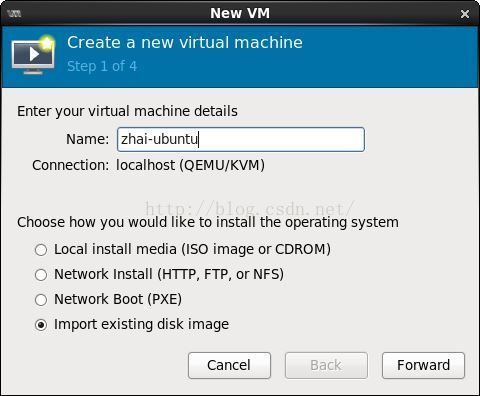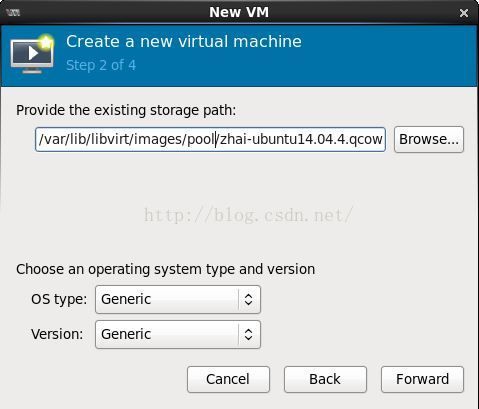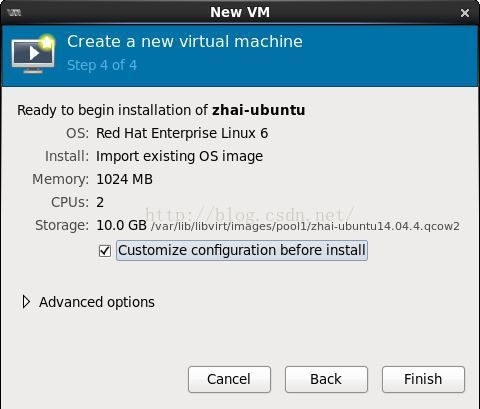1 ubuntu下安装: apt-get install virtinst
- # apt-get install virtinst
- Reading package lists... Done
- Building dependency tree
- Reading state information... Done
- The following extra packages will be installed:
- adwaita-icon-theme at-spi2-core colord colord-data dconf-gsettings-backend dconf-service fontconfig fontconfig-config
- fonts-dejavu-core glib-networking glib-networking-common glib-networking-services gsettings-desktop-schemas hicolor-icon-theme
- ...
- libxinerama1 libxkbcommon0 libxpm4 libxrandr2 libxrender1 libxtst6 python-libxml2 python-pycurl python-urlgrabber ubuntu-mono
- virt-viewer x11-common
- Suggested packages:
- colord-sensor-argyll cups-common libgd-tools gphoto2 gvfs liblcms2-utils librsvg2-bin avahi-daemon hplip libsane-extras
- sane-utils python-pycurl-dbg python-pycurl-doc
- ...
2 virt-install常用参数
-n --name= 客户端虚拟机名称
-r --ram= 客户端虚拟机分配的内存
-u --uuid= 客户端UUID 默认不写时,系统会自动生成
--vcpus= 客户端的vcpu个数
-v --hvm 全虚拟化
-p --paravirt 半虚拟化
-l --location=localdir 安装源,有本地、nfs、http、ftp几种,多用于ks网络安装
--vnc 使用vnc ,另有--vnclient=监听的IP --vncport =VNC监听的端口
-c --cdrom= 光驱 安装途径
--disk= 使用不同选项作为磁盘使用安装介质
-w NETWORK, --network=NETWORK 连接客户机到主机网络
-s --file-size= 使用磁盘映像的大小 单位为GB
-f --file= 作为磁盘映像使用的文件
--cpuset=设置哪个物理CPU能够被虚拟机使用
--os-type=OS_TYPE 针对一类操作系统优化虚拟机配置(例如:‘linux’,‘windows’)
--os-variant=OS_VARIANT 针对特定操作系统变体(例如’rhel6’, ’winxp’,'win2k3')进一步优化虚拟机配置
--host-device=HOSTDEV 附加一个物理主机设备到客户机。HOSTDEV是随着libvirt使用的一个节点设备名(具体设备如’virsh nodedev-list’的显示的结果)
--accelerate KVM或KQEMU内核加速,这个选项是推荐最好加上。如果KVM和KQEMU都支持,KVM加速器优先使用。
-x EXTRA, --extra-args=EXTRA 当执行从"--location"选项指定位置的客户机安装时,附加内核命令行参数到安装程序
--nographics "virt-install" 将默认使用--vnc选项,使用nographics指定没有控制台被分配给客户机
3 安装
Use the virt-installtool to boot the virtual machine through libvirt and connect to the graphical console from a VNC client installed on your local machine.
3.1 查看default网络
- # virsh net-list
- Name State Autostart Persistent
- ----------------------------------------------------------
- default active yes yes
If the network is not active, start it by doing:
# virsh net-start default
Starting this network will create a Linux bridge (usually called virbr0), iptables rules, and a dnsmasq process that will serve as a DHCP server.
查看default网络的配置
- root@zhaicompute# brctl show
- bridge name bridge id STP enabled interfaces
- virbr0 8000.5254000f5c96 yes virbr0-nic
-
- root@zhaicompute# ifconfig virbr0
- virbr0 Link encap:Ethernet HWaddr 52:54:00:0f:5c:96
- inet addr:192.168.22.1 Bcast:192.168.22.255 Mask:255.255.255.0
- UP BROADCAST RUNNING MULTICAST MTU:1500 Metric:1
- RX packets:0 errors:0 dropped:0 overruns:0 frame:0
- TX packets:0 errors:0 dropped:0 overruns:0 carrier:0
- collisions:0 txqueuelen:0
- RX bytes:0 (0.0 B) TX bytes:0 (0.0 B)
- root@zhaicompute# cat /etc/libvirt/qemu/networks/default.xml
-
-
-
- default
- 6acb-ed0a-4ad1-b8dc-527168a2
-
-
-
-
-
-
-
-
-
default网络设置保存在/etc/libvirt/qemu/networks目录下,从配置中可看出具体的网桥virbr0.
3.2 qemu-img和virt-install
qemu-img command to create an empty image file
- root@zhaicompute# qemu-img create -f qcow2 zhai-ubuntu14.04.4.qcow2 10G
- Formatting 'zhai-ubuntu14.04.4.qcow2', fmt=qcow2 size=10737418240 encryption=off cluster_size=65536 lazy_refcounts=off refcount_bits=16
- root@zhaicompute# ls
- ubuntu-14.04.3-server-ppc64el.iso zhai-ubuntu14.04.4.qcow2
- root@zhaicompute# qemu-img info zhai-ubuntu14.04.4.qcow2
- image: zhai-ubuntu14.04.4.qcow2
- file format: qcow2
- virtual size: 10G (10737418240 bytes)
- disk size: 196K
- cluster_size: 65536
- Format specific information:
- compat: 1.1
- lazy refcounts: false
- refcount bits: 16
- corrupt: false
virt-install command to start up a virtual machine using that image file.
命令行:
- virt-install --virt-type kvm --name zhai-ubuntu --ram 1024 \
- > --cdrom=/var/lib/libvirt/images/zhaipool/ubuntu-14.04.4-server-ppc64el.iso \
- > --disk /var/lib/libvirt/images/zhaipool/zhai-ubuntu14.04.4.qcow2,format=qcow2 \
- > --network network=default \
- > --graphics vnc,listen=0.0.0.0 --noautoconsole \
- > --os-type=linux --os-variant=ubuntutrusty
其中,--os-variant后面的值使用virt-install --os-variant list查看
- root@zhaicompute# virt-install --os-variant list
- win2k8 : Microsoft Windows Server 2008 (or later)
- win2k3 : Microsoft Windows Server 2003
- win7 : Microsoft Windows 7 (or later)
- vista : Microsoft Windows Vista
- winxp64 : Microsoft Windows XP (x86_64)
- winxp : Microsoft Windows XP
- win2k : Microsoft Windows 2000
- openbsd4 : OpenBSD 4.x (or later)
- freebsd9 : FreeBSD 9.x
- freebsd8 : FreeBSD 8.x
- freebsd7 : FreeBSD 7.x
- freebsd6 : FreeBSD 6.x
- freebsd10 : FreeBSD 10.x (or later)
- solaris9 : Sun Solaris 9
- solaris11 : Sun Solaris 11 (or later)
- solaris10 : Sun Solaris 10
- opensolaris : Sun OpenSolaris (or later)
- netware6 : Novell Netware 6 (or later)
- netware5 : Novell Netware 5
- netware4 : Novell Netware 4
- msdos : MS-DOS
- generic : Generic
- altlinux : ALT Linux (or later)
- debianwheezy : Debian Wheezy (or later)
- debiansqueeze : Debian Squeeze
- debianlenny : Debian Lenny
- debianetch : Debian Etch
- fedora20 : Fedora 20 (or later)
- fedora19 : Fedora 19
- fedora18 : Fedora 18
- fedora17 : Fedora 17
- fedora16 : Fedora 16
- fedora15 : Fedora 15
- fedora14 : Fedora 14
- fedora13 : Fedora 13
- fedora12 : Fedora 12
- fedora11 : Fedora 11
- fedora10 : Fedora 10
- fedora9 : Fedora 9
- fedora8 : Fedora 8
- fedora7 : Fedora 7
- fedora6 : Fedora Core 6
- fedora5 : Fedora Core 5
- mes5.1 : Mandriva Enterprise Server 5.1 (or later)
- mes5 : Mandriva Enterprise Server 5.0
- mandriva2010 : Mandriva Linux 2010 (or later)
- mandriva2009 : Mandriva Linux 2009 and earlier
- mageia1 : Mageia 1 (or later)
- rhel7 : Red Hat Enterprise Linux 7 (or later)
- rhel6 : Red Hat Enterprise Linux 6
- rhel5.4 : Red Hat Enterprise Linux 5.4 or later
- rhel5 : Red Hat Enterprise Linux 5
- rhel4 : Red Hat Enterprise Linux 4
- rhel3 : Red Hat Enterprise Linux 3
- rhel2.1 : Red Hat Enterprise Linux 2.1
- sles11 : Suse Linux Enterprise Server 11 (or later)
- sles10 : Suse Linux Enterprise Server
- opensuse12 : openSuse 12 (or later)
- opensuse11 : openSuse 11
- ubuntuutopic : Ubuntu 14.10 (Utopic Unicorn) (or later)
- ubuntutrusty : Ubuntu 14.04 LTS (Trusty Tahr)
- ubuntusaucy : Ubuntu 13.10 (Saucy Salamander)
- ubunturaring : Ubuntu 13.04 (Raring Ringtail)
- ubuntuquantal : Ubuntu 12.10 (Quantal Quetzal)
- ubuntuprecise : Ubuntu 12.04 LTS (Precise Pangolin)
- ubuntuoneiric : Ubuntu 11.10 (Oneiric Ocelot)
- ubuntunatty : Ubuntu 11.04 (Natty Narwhal)
- ubuntumaverick : Ubuntu 10.10 (Maverick Meerkat)
- ubuntulucid : Ubuntu 10.04 LTS (Lucid Lynx)
- ubuntukarmic : Ubuntu 9.10 (Karmic Koala)
- ubuntujaunty : Ubuntu 9.04 (Jaunty Jackalope)
- ubuntuintrepid : Ubuntu 8.10 (Intrepid Ibex)
- ubuntuhardy : Ubuntu 8.04 LTS (Hardy Heron)
- mbs1 : Mandriva Business Server 1 (or later)
- virtio26 : Generic 2.6.25 or later kernel with virtio
- generic26 : Generic 2.6.x kernel
- generic24 : Generic 2.4.x kernel
执行过程:
- root@zhaicompute# virt-install --virt-type kvm --name zhai-ubuntu --ram 1024 \
- > --cdrom=/var/lib/libvirt/images/zhaipool/ubuntu-14.04.4-server-ppc64el.iso \
- > --disk /var/lib/libvirt/images/zhaipool/zhai-ubuntu14.04.4.qcow2,format=qcow2 \
- > --network network=default \
- > --graphics vnc,listen=0.0.0.0 --noautoconsole \
- > --os-type=linux --os-variant=ubuntutrusty
-
-
- Starting install...
- Creating domain... | 0 B 00:00
- Domain installation still in progress. You can reconnect to
- the console to complete the installation process.
- root@zhaicompute# ps -ef | grep zhai
- libvirt+ 27531 1 99 03:39 ? 00:00:22 qemu-system-ppc64 -enable-kvm -name zhai-ubuntu -S -machine pseries-2.3,accel=kvm,usb=off -m 1024 -realtime mlock=off -smp 1,sockets=1,cores=1,threads=1 -uuid de480a35-4ab5-42e5-b3b6-a47c8b05d9c8 -no-user-config -nodefaults -chardev socket,id=charmonitor,path=/var/lib/libvirt/qemu/zhai-ubuntu.monitor,server,nowait -mon chardev=charmonitor,id=monitor,mode=control -rtc base=utc -no-reboot -boot strict=on -device pci-ohci,id=usb,bus=pci.0,addr=0x2 -device spapr-vscsi,id=scsi0,reg=0x2000 -drive file=/var/lib/libvirt/images/zhaipool/zhai-ubuntu14.04.4.qcow2,if=none,id=drive-scsi0-0-0-0,format=qcow2 -device scsi-hd,bus=scsi0.0,channel=0,scsi-id=0,lun=0,drive=drive-scsi0-0-0-0,id=scsi0-0-0-0,bootindex=2 -drive file=/var/lib/libvirt/images/zhaipool/ubuntu-14.04.4-server-ppc64el.iso,if=none,id=drive-scsi0-0-0-1,readonly=on,format=raw -device scsi-cd,bus=scsi0.0,channel=0,scsi-id=0,lun=1,drive=drive-scsi0-0-0-1,id=scsi0-0-0-1,bootindex=1 -netdev tap,fd=29,id=hostnet0 -device rtl8139,netdev=hostnet0,id=net0,mac=52:54:00:cb:ad:fa,bus=pci.0,addr=0x1 -chardev pty,id=charserial0 -device spapr-vty,chardev=charserial0,reg=0x30000000 -device usb-kbd,id=input0 -device usb-mouse,id=input1 -vnc 0.0.0.0:2 -device VGA,id=video0,vgamem_mb=16,bus=pci.0,addr=0x4 -device virtio-balloon-pci,id=balloon0,bus=pci.0,addr=0x3 -msg timestamp=on
- root 27540 23850 0 03:40 pts/8 00:00:00 grep --color=auto zhai
从上看出:virt-install执行后,最终调用的是qemu-system-ppc64命令来创建vm。
一个虚拟机占用一个进程,可以通过进程管理和控制虚拟机。
log日志:
- root@zhaicompute# ls /var/log/libvirt/qemu/
- zhai-ubuntu.log
创建后,查看网络:
- root@zhaicompute# brctl show
- bridge name bridge id STP enabled interfaces
- virbr0 8000.5254000f5c96 yes virbr0-nic
- vnet0
可看出
virbr0上多了一下端口vnet0.
- virbr0 Link encap:Ethernet HWaddr 52:54:00:0f:5c:96
- inet addr:192.168.122.1 Bcast:192.168.122.255 Mask:255.255.255.0
- UP BROADCAST RUNNING MULTICAST MTU:1500 Metric:1
- RX packets:10646 errors:0 dropped:0 overruns:0 frame:0
- TX packets:14645 errors:0 dropped:0 overruns:0 carrier:0
- collisions:0 txqueuelen:0
- RX bytes:617571 (617.5 KB) TX bytes:20396983 (20.3 MB)
-
- virbr0-nic Link encap:Ethernet HWaddr 52:54:00:0f:5c:96
- BROADCAST MULTICAST MTU:1500 Metric:1
- RX packets:0 errors:0 dropped:0 overruns:0 frame:0
- TX packets:0 errors:0 dropped:0 overruns:0 carrier:0
- collisions:0 txqueuelen:500
- RX bytes:0 (0.0 B) TX bytes:0 (0.0 B)
-
- vnet0 Link encap:Ethernet HWaddr fe:54:00:7e:60:d0
- inet6 addr: fe80::fc54:ff:fe7e:60d0/64 Scope:Link
- UP BROADCAST RUNNING MULTICAST MTU:1500 Metric:1
- RX packets:10646 errors:0 dropped:0 overruns:0 frame:0
- TX packets:17480 errors:0 dropped:0 overruns:0 carrier:0
- collisions:0 txqueuelen:500
- RX bytes:766615 (766.6 KB) TX bytes:20544635 (20.5 MB)
查看生成的xml配置文件 :
- # ls -lrt /etc/libvirt/qemu
- -rw------- 1 root root 2511 Apr 15 11:25 zhai-ubuntu.xml
zhai-ubuntu.xml内容:
- # cat /etc/libvirt/qemu/zhai-ubuntu.xml
-
-
-
- zhai-ubuntu
- 0e5684f5-23aa-8568-ed10-52c844b4d85d
- 1048576
- 1048576
- 2
-
- hvm
-
-
-
-
-
-
-
-
-
-
- destroy
- restart
- restart
-
- /usr/bin/kvm
-
-
-
-
-
-
-
-
-
-
-
-
-
-
-
-
-
-
-
-
-
-
-
-
-
-
-
-
-
-
-
-
-
-
-
-
-
-
-
-
-
-
基于KVM建立的虚拟机相关文件默认存放位置
kvm虚拟机配置文件位置/etc/libvirt/qemu/ <---都是xml文件
kvm虚拟机文件位置:/var/lib/libvirt/images/ <---可以在建立虚拟机时指定
建立的虚拟机在运行时相关文件及存放位置
在虚拟机运行时,会在/var/run/libvirt/qemu目录下存放虚拟机的pid文件和配置文件,配置文件与/etc/libvirt/qemu目录下对应的虚拟机文件相同,pid文件保存有此虚拟机进程号。虚拟机的日志文件存放在/var/log/libvirt/qemu目录下,每个虚拟机一个,文件名称为:虚拟机名称(或UUID)+“.log”
virt-install在生产虚拟机的最后调用virt-viewer打开虚拟机图形界面
,进行操作系统的安装,可以通过vnc或者virt-manager打开虚拟机图形界面,继续完成guest操作系统的安装即可。
3.3 virsh vncdisplay命令
Use the virsh vncdisplay vm-name command to get the VNC port number.
- root@zhaicompute# virsh vncdisplay zhai-ubuntu
- :2
- root@zhaicompute# ps -ef | grep vnc
- libvirt+ 27531 1 99 03:39 ? 00:09:35 qemu-system-ppc64 -enable-kvm -name zhai-ubuntu -S -machine pseries-2.3,accel=kvm,usb=off -m 1024 -realtime mlock=off -smp 1,sockets=1,cores=1,threads=1 -uuid de480a35-4ab5-42e5-b3b6-a47c8b05d9c8 -no-user-config -nodefaults -chardev socket,id=charmonitor,path=/var/lib/libvirt/qemu/zhai-ubuntu.monitor,server,nowait -mon chardev=charmonitor,id=monitor,mode=control -rtc base=utc -no-reboot -boot strict=on -device pci-ohci,id=usb,bus=pci.0,addr=0x2 -device spapr-vscsi,id=scsi0,reg=0x2000 -drive file=/var/lib/libvirt/images/zhaipool/zhai-ubuntu14.04.4.qcow2,if=none,id=drive-scsi0-0-0-0,format=qcow2 -device scsi-hd,bus=scsi0.0,channel=0,scsi-id=0,lun=0,drive=drive-scsi0-0-0-0,id=scsi0-0-0-0,bootindex=2 -drive file=/var/lib/libvirt/images/zhaipool/ubuntu-14.04.4-server-ppc64el.iso,if=none,id=drive-scsi0-0-0-1,readonly=on,format=raw -device scsi-cd,bus=scsi0.0,channel=0,scsi-id=0,lun=1,drive=drive-scsi0-0-0-1,id=scsi0-0-0-1,bootindex=1 -netdev tap,fd=29,id=hostnet0 -device rtl8139,netdev=hostnet0,id=net0,mac=52:54:00:cb:ad:fa,bus=pci.0,addr=0x1 -chardev pty,id=charserial0 -device spapr-vty,chardev=charserial0,reg=0x30000000 -device usb-kbd,id=input0 -device usb-mouse,id=input1 -vnc 0.0.0.0:2 -device VGA,id=video0,vgamem_mb=16,bus=pci.0,addr=0x4 -device virtio-balloon-pci,id=balloon0,bus=pci.0,addr=0x3 -msg timestamp=on
3.4 在本机上使用vncviewer或tigervnc连接
qemu不使用Linux下的vncserver提供vnc服务,因此在此服务没有启动的情况下,也能通过vnc客户端连接到虚拟机。
在win7下,打开vnc-viewer,输入virt-install命令所在的服务器IP与所安装的虚拟机据点用的vnc端口号0;

点击“OK”,进入安装界面

安装完成后,使用命令virsh start vm-name启动此虚拟机:
- root@ctler:~# virsh list --all
- Id Name State
- ----------------------------------------------------
- - net shut off
-
- root@ctler:~# virsh start net
- Domain net started
-
- root@ctler:~# virsh list --all
- Id Name State
- ----------------------------------------------------
- 5 net running
在linux下:

安装完成后,登录虚机,查看IP

4 本地安装示例
给guest主机划分物理机分区
lvcreate -L20G -n host.demo.com kvm-storage
下载镜像并loop到本地:
wget http://mirrors.manchester.icecolo.com/centos/5.5/isos/x86_64/CentOS-5.5-x86_64-bin-1of8.iso
mkdir /mnt/centos55
mount -o loop CentOS-5.5-x86_64-bin-1of8.iso /mnt/centos55/
通过location本地安装,并通过console管理:
virt-install
-n host.demo.com
-r 512
--vcpus=1
--os-variant=rhel5.4
--accelerate
--nographics
-v
-l /mnt/centos55/
-w bridge:br1
--disk path=/dev/kvm-storage/host.demo.com
-x "console=ttyS0"
管理时可以通过
#查看guest id、name 及状态
virsh list --all
#通过console连接查看
virsh console id或name
#连接完成后会要求输入用户名和密码
5 virt-manager图形安装
通过图形向导界面也可以完成安装,virt-manager可以通过在终端中输入virt-manager或者从菜单应用程序->系统工具中打开。







参考:
1 virt-install 使用说明: http://blog.csdn.NET/starshine/article/details/6998189
2 kvm, qemu-kvm以及libvirt之间的关系图:http://blog.csdn.net/zhaihaifei/article/details/51018113
3 kvm虚拟化之virt-install: http://www.361way.com/virt-install/2721.html
4 kvm显示VM的IP:http://www.chengxuyuans.com/Unix/83251.html
5 virbr0: http://blog.chinaunix.Net/uid-26000137-id-3723948.html










